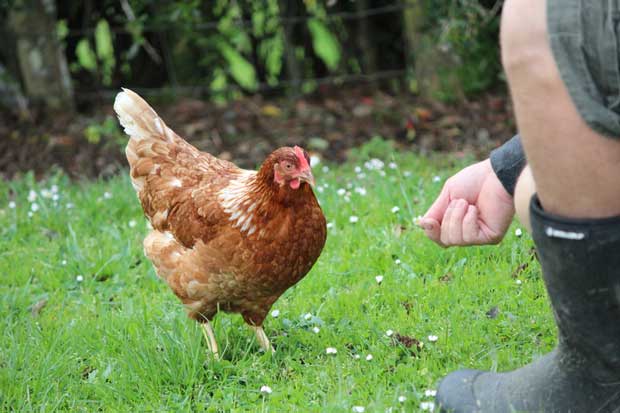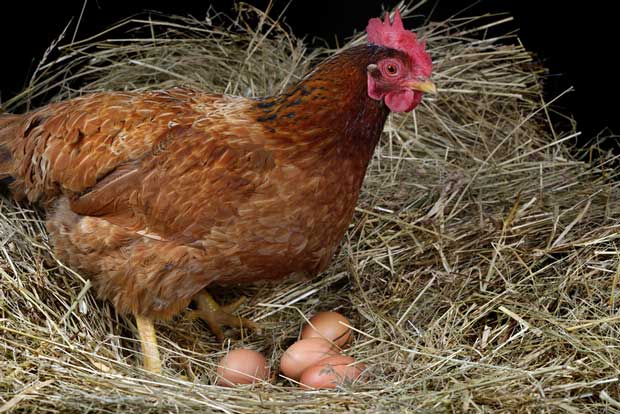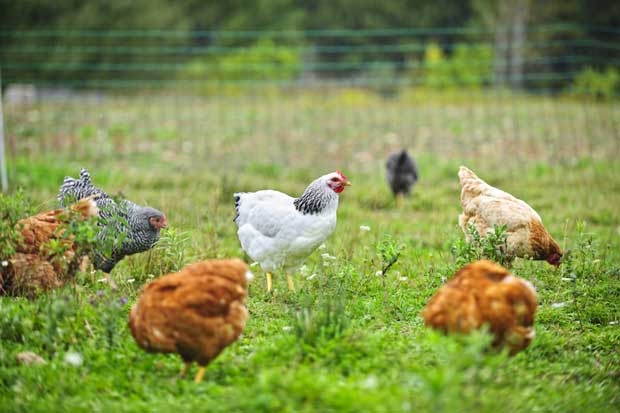Why natural health products for chickens are about to take off

With more commercial farms turning free-range, there are going to be exciting, more natural, scientifically-proven ways to fight diseases for all of us.
Words: Sue Clarke
It would be nice to believe that free-ranging chickens in the garden or on a block are healthier than huge flocks of commercially-farmed, intensively-housed poultry being reared for meat for the masses or eggs for all those millions unable to keep their own chickens.
Unfortunately this is not always the case, so what makes the difference?
Keeping chickens isolated in large sheds and buying in chicks from large-scale breeding companies gives a commercial farmer a big advantage. They get the benefit of breeding programmes behind them that work to eliminate egg-transmitted diseases like leucosis and mycoplasmas, they have vaccination programmes starting when the chicks are less than 24 hours old against salmonella and Marek’s disease in the egg-laying pullets. That continues in the rearing phase, with vaccines protecting birds from common diseases like infectious bronchitis, fowl pox, infectious laryngotracheitis and egg drop syndrome.
These are all common diseases in chickens, but many go undiagnosed in backyard flocks because there are so many variables in terms of disease control, prevention, feeding regimes, and vaccinations. It’s unusual for backyard flocks to be vaccinated as vaccinations are expensive and it’s difficult (if not impossible) to fulfil quarantine requirements.
The commercial farmer also has easy access to poultry experts and avian vets who can diagnose, treat and monitor flock health on an ongoing basis, not just when some birds fall sick and die. This means timely intervention, isolation and treatment before a disease becomes widespread.
The biggest threat to a commercial farmer is the pool of diseases which circulate throughout the many urban, farm and lifestyle block flocks. These are spread in dust and contaminated materials and the source birds often go untreated. The pathogens get carried onto large poultry operations and this is why they practice strict biosecurity.

RESCUE BIRDS
There is a belief that ‘rescue’ cage hens need worming upon leaving a commercial farm. But they are more likely to need treatment to help them overcome the parasites and disease they are likely to meet once they are allowed to scratch around on the ground out in the fresh air, where these parasites abound. Many often die once they are rescued, but their early demise is often because of their naïve disease and parasite status, having been confined away from their droppings, the ground and all but a few close neighbours.
Commercial flocks are usually of one type of bird, of one age, and live in a relatively confined area. They have little exposure to pathogen-carrying pests like wild birds, rodents, and outside visitors from other poultry sites carrying dust and dirt on their clothing and shoes, which means their exposure to disease is lessened. If something does affect them, it is diagnosed and treated without delay.
Despite large populations of poultry concentrated in one site, commercial poultry can remain very healthy thanks to all the support that is in place and the efforts taken to keep out disease organisms. Mortality levels due to a disease are far below those which seem to occur among small backyard flocks. The birds also get protection from marauding stoats, hedgehogs, hawks, cats and dogs so losses from predation are virtually nil.
HOW WILL WE PREVENT DISEASE IN THE FUTURE

With more people now wanting their supermarket eggs or roast to come from free range poultry flocks, layer and meat chickens are being farmed in less confined, less intensive systems.
That has meant diseases which had almost been confined to the history books have started to reappear and cause concern in many countries.
This emergence of serious disease issues, combined with the banning of some antibiotics and antimicrobials used to treat poultry (due to the conflict in using the same products to treat human diseases which is believed to be causing drug resistance) has become a big concern for those who treat poultry diseases.
There are new products rapidly being discovered and trialled to replace the banned medicines and preventatives. The increase in diseases in the more consumer-preferred forms of farming is going to need effective treatments readily at hand or the serious issues of animal welfare will be compromised due to diseases becoming rampant.
Acidifiers, probiotics, prebiotics, fatty acids, essential oils and spices are all being looked at and developed into products. Some of the ingredients have been used by hobby poultry breeders for years and are known to work, but scientists don’t know how or why.
The issue now is to develop products on a vast scale so that they can be safely administered through food or water to thousands of birds at the same time. Some products, like spices, can be easily contaminated at source with bacteria like salmonella, which in itself can cause a huge issue in a large flock of birds.
One of the big issues in the poultry world is the withdrawal of some antibiotics and growth enhancers from general use in poultry production systems, due to consumer demand and because of antibiotic resistance.
Some alternative products are being investigated and developed. The bonus is they will prove to be useful in the treatment of conditions in humans where antibiotics were once the treatment of choice but are now ineffective.
PROBIOTICS
These are a culture of a single strain, or a mixture of several strains of bacteria, which will be able to colonise the gut of a bird. The idea is they can outnumber and reduce the damage done by harmful bacteria such as salmonella or E. coli.
PREBIOTICS
Non-digestible carbohydrates or oligosaccharides are thought to enhance the growth of beneficial organisms in the gut, increasing feed efficiency and reducing the presence of salmonella.
They are found naturally in some cereal crops and in onions and also in the cell walls of yeasts.
ORGANIC ACIDS
Work using the addition of formic acid and proprionic acid to drinking water and feed in trials has been found to have a beneficial effect in reducing the numbers of bacteria in the gut, especially the lactic acid-producing bacterias.
Further work using 0.1% acetic acid (vinegar) shows it has an inhibiting effect on 17 strains of bacteria including Salmonella typhimurium and eight strains of E. coli. This suggests that the addition of vinegar to water or feed could reduce the bacterial load in the gut and help reduce the spread within the flock.
Cider vinegar has long been held as a tonic and treatment, but white vinegar works equally well. It will not eliminate worms and mites as many people mistakenly believe, but it does create a more healthy gut flora, which in turn helps to boost the birds’ health status.
PLANT EXTRACTS

Oregano is known to reduce pathogens and work as an insect repellent.
Essential oils derived from plants and extracts found in certain spices have long proved beneficial and some have been used historically, despite the active chemical involved having not been known or isolated.
Some aromatic plants have chemical properties which are known to be helpful, and the most widely used is oregano. It and other plants which contain terpenoids have been used for centuries as traditional remedies, including thyme, eucalyptus, mint and anise. They are known to reduce pathogens, work as an insect repellent, and have appetising and aromatic effects.
Oregano and thyme in particular can have a supressing effect on common food-borne pathogens like E. coli, salmonella and campylobacter. Used together, they have an even better effect than when used separately. Products developed from these oils, containing carvacrol, are known to work in the digestive tract where they combat fungus, bacteria, virus and coccidiosis and they have a positive effect on digestive enzymes helping improve feed efficiency and growth.
A blend of various components of extracts has been found to control Clostridium perfringens, the bacterial cause of necrotic enteritis in broiler chickens. It’s the most likely cause of digestive upsets causing diarrhoea in backyard flocks with access to fouled, wet litter.
Eugenol is found in the essential oil of cloves and shown to inhibit salmonella in trial work. Other plant extracts under trial include oil of black pepper and cinnamon.
Lastly there is garlic (in feed) and cloves (in drinking water) which have been used for many years by backyard flock owners. Trials have now shown they have useful anti-bacterial properties, especially against salmonella and E. coli, and are showing great promise for use on a large scale.
THE TRUTH ABOUT EGG YOLKS
Many people believe that eggs with golden-yellow yolks are better for you because they are richer in vitamins. Some even say they taste better. Yolk colour is due to orange-yellow pigments derived from plants and grains eaten by the hen. If the hen has eaten grass, maize, carrots or pumpkin the yolk will be darker. Generally the nutritional value between different coloured yolks is minor.
Reference
Alternatives to Antibiotics for Organic Poultry Production, World Poultry Science (2005)
https://japr.oxfordjournals.org/content/14/4/750.full.pdf
READ MORE
Super hens or old-fashioned girls: a guide to poultry breeds
 This article first appeared in NZ Lifestyle Block Magazine.
This article first appeared in NZ Lifestyle Block Magazine.
